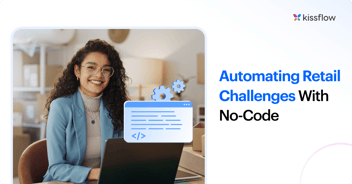
Top Retail Technology Trends Shaping the Future in 2026
The retail industry is changing as new technologies redefine how consumers engage with brands and businesses operate. AI, IoT, and augmented reality are revolutionizing supply chains, improving customer experiences, and creating a more agile, data-driven retail landscape. To remain competitive in this evolving landscape, retailers must adopt innovative IT solutions that enable seamless, personalized interactions across multiple channels and optimize operations.
Retail technology trends continue to reshape the industry, transforming consumer-facing and back-end processes. Low-code and no-code platforms empower retail teams to develop custom applications without relying heavily on IT, accelerating innovation and reducing IT backlogs. By 2026, embracing these advancements will be essential for long-term success, allowing retailers to stay agile, respond quickly to market demands, and deliver personalized, efficient services. Retailers leading modernization will drive customer-centric solutions, while those that fail to adapt will fall behind in the rapidly evolving industry.
1. Low-Code Application Platforms (LCAP) in Retail:
Solving Retail Backlogs: Low-code application platforms (LCAP) allow retailers to build custom apps swiftly, reducing the strain on IT teams and addressing the backlog of internal application requests. By simplifying app development, LCAP helps businesses create solutions faster, cutting down lengthy coding processes and boosting efficiency. Accelerated app development is crucial for retailers aiming to streamline operations, enhance customer service, and remain adaptable to market changes.
Empowering Retail Teams: One key benefit of LCAP is its accessibility to non-technical staff. Retail employees who manage daily operations can use these platforms to develop workflows and applications without needing in-depth coding knowledge, empowering teams to respond quickly to operational challenges, whether creating a tool to track inventory in real-time or automating routine processes. LCAP ensures faster, more flexible responses to retail demands by allowing staff to develop solutions as they identify needs.
Use Cases in Retail: LCAP is transforming multiple aspects of retail operations. Retailers use low-code platforms to automate inventory management, ensuring that stock levels are tracked accurately and restocked efficiently. LCAP also optimizes supply chain operations, enabling retailers to react to shifts in demand faster. Additionally, the platform enhances in-store and online customer experiences, from personalized shopping tools to streamlined checkout processes.
Kissflow’s LCAP in Action: The CaratLane Success Story
When faced with an increasing IT backlog and a pressing need to innovate, CaratLane turned to Kissflow’s Low-Code Application Platform (LCAP). With the flexibility to build and deploy custom apps in a matter of days, CaratLane streamlined its operations and responded to real-time challenges in a fast-changing retail landscape.
By leveraging Kissflow, CaratLane reduced its application development time by an impressive 80%, allowing the company to focus on enhancing operational efficiency and customer experience. This newfound agility eliminated IT bottlenecks and empowered business teams to take the lead in innovation, making CaratLane more responsive and competitive.
CaratLane’s success story showcases how Kissflow's LCAP can be a game-changer for retailers, offering a faster, more innovative way to solve operational challenges and drive growth.
Discover more about how Kissflow transformed CaratLane here.
2. Citizen Development Application Platforms (CDAP): Empowering the Workforce
Empowering Retail Employees: Citizen Development Application Platforms (CDAP) are revolutionizing retail by empowering non-technical employees, such as store managers and sales teams, to build applications without IT expertise. These platforms provide intuitive, drag-and-drop interfaces that allow retail staff to create solutions tailored to their specific operational needs. Whether developing a real-time inventory tracker, setting up customer loyalty programs, or creating scheduling tools for staff, CDAP enables employees to solve problems independently, boosting productivity and responsiveness. By allowing frontline workers to design apps that meet day-to-day challenges, CDAP creates a more agile and empowered workforce.
Reducing IT Burden: CDAP significantly reduces the dependency on IT teams for app development, freeing up IT resources to focus on more complex, strategic projects. Retail teams often need to wait weeks or months for IT to develop and implement a new tool in traditional settings. With CDAP, those same teams can create functional apps in hours or days, allowing for faster innovation cycles. This autonomy accelerates problem-solving and enables IT departments to focus on maintaining and enhancing critical infrastructure without being bogged down by routine requests.
Real-World Applications in Retail: CDAP is transforming various aspects of retail operations. For example, store managers can automate reporting processes, eliminating the need for manual data entry and reducing errors. Sales teams can develop feedback systems that gather real-time customer preferences and satisfaction insights, allowing immediate action to improve service. Custom apps that guide new hires through training, policy acknowledgment, and workflow familiarization can also streamline employee onboarding processes. These real-world applications highlight how CDAP enhances operational efficiency and improves customer and employee experience.
3. Artificial Intelligence (AI) and Machine Learning (ML):
AI and Machine Learning are reshaping retail by transforming customer interaction and operations. Powered by AI, predictive analytics helps retailers forecast demand, optimize inventory, and create dynamic pricing strategies. According to Deloitte, predictive analytics can boost sales by up to 15% through better inventory management and personalized marketing.
Moreover, chatbots powered by AI are revolutionizing customer service. By 2026, Gartner estimates that chatbots will handle over 85% of customer interactions in retail. These AI-powered tools provide 24/7 support, answering queries, assisting with orders, and offering personalized shopping recommendations. Major retailers like Amazon and Sephora already use AI to tailor customer experiences, driving higher engagement and sales.
AI and Machine Learning are reshaping retail by transforming customer interaction and operations. Powered by AI, predictive analytics helps retailers forecast demand, optimize inventory, and create dynamic pricing strategies. According to Deloitte, predictive analytics can boost sales by up to 15% through better inventory management and personalized marketing.
Moreover, chatbots powered by AI are revolutionizing customer service. By 2025, Gartner estimates that chatbots will handle over 85% of customer interactions in retail. These AI-powered tools provide 24/7 support, answering queries, assisting with orders, and offering personalized shopping recommendations. Major retailers like Amazon and Sephora already use AI to tailor customer experiences, driving higher engagement and sales.
Retailers using platforms like Kissflow, with AI-powered automation, have seen similar gains. Kissflow’s AI-driven workflows help streamline inventory management, customer support, and marketing operations. By automating repetitive tasks and providing intelligent insights, Kissflow allows retail businesses to enhance efficiency, reduce costs, and deliver more personalized customer experiences without extensive coding. This AI-first approach empowers business and IT teams to focus on innovation while improving overall retail operations.
4. Internet of Things (IoT):
The Internet of Things (IoT) has revolutionized retail by creating a connected ecosystem from supply chains to customer touchpoints. IoT implementations enhance operational efficiency, with McKinsey reporting that IoT can reduce operational costs by up to 30% through better asset tracking and inventory management.
Retailers like Amazon have leveraged IoT to introduce cashier-less stores, creating seamless and convenient customer shopping experiences. By using sensors, RFID tags, and beacons, IoT enables real-time inventory tracking, reducing the chances of stockouts and improving customer satisfaction.
5. Cloud Computing:
Cloud computing is critical for modern retailers' scaling and agility. A projection by MarketsandMarkets estimates that the global retail cloud market will reach $100 billion by 2026, driven by the increasing adoption of cloud solutions for scalability and flexibility. (MarketsandMarkets). The cloud-based infrastructure allows retailers to scale on demand during peak shopping seasons and ensures robust disaster recovery. Retailers utilizing cloud solutions report a 60 percent improvement in disaster recovery capabilities, ensuring business continuity.
6. Data Analytics:
Retailers have access to massive amounts of data from sales, customer interactions, and logistics. By utilizing advanced data analytics, retailers can gain actionable insights, optimize operations, and deliver personalized marketing. According to Epsilon, customized marketing can increase customer engagement by up to 80%.
Moreover, Retailers leveraging data can reduce supply chain costs by 10%, leading to better forecasting, inventory management, and operational efficiency.
7. Omnichannel Integration:
Omnichannel retail strategies are vital to providing a seamless shopping experience across all channels. A Harvard Business Review study shows that businesses with robust omnichannel strategies retain 89% of their customers, compared to 33% for businesses with weaker strategies. Technologies such as CRM systems and inventory management platforms allow retailers to offer consistent experiences across in-store, online, and mobile channels. Salesforce found that over 75% of customers expect a unified experience across all touchpoints, making omnichannel integration vital for customer retention.
8. Robotics and Automation in Retail
Automation rapidly enhances efficiency in retail operations, especially in warehousing and logistics. According to PwC, automation technologies improve efficiency by 25%, enabling faster order fulfillment and reducing labor costs by up to 30%. Robots handle repetitive tasks such as picking, packing, and inventory management, allowing retailers to streamline operations and focus on customer-centric activities.
Learn more about logistics management software.
9. Future Trends in Retail Technology: What’s Next?
5G Connectivity is expected to revolutionize mobile shopping, offering speeds up to 100 times faster than current networks, enhancing customer experience with real-time data and mobile commerce capabilities. As reported by Deloitte, blockchain technology is another future trend, with over 40% of retailers exploring its use for supply chain transparency and fraud prevention.
Kissflow’s Role in Retail Transformation: Accelerating Development with Low-Code and No-Code Solutions
Retailers adopting Kissflow’s platform have seen up to a 70% reduction in application development time. Kissflow enables IT teams to overcome backlogs and allows business departments to build solutions faster. With the ability to automate workflows, retailers report an average 20% improvement in operational efficiency. The platform's scalability ensures that retailers adapt quickly as business needs evolve. Kissflow’s low-code and no-code approach lets process owners control app development, drive innovation, streamline operations, and elevate customer experiences.
Why Use Kissflow for No-Code and Low-Code Solutions in Retail?
Kissflow’s Role in Retail Technology: Kissflow is a leading Low-Code and No-Code platform enabling retailers to create custom applications without extensive technical expertise. By providing a flexible, user-friendly platform, Kissflow allows retail teams to build and manage apps that streamline operations, optimize supply chains, and enhance the customer experience. Whether creating an automated inventory management system or a real-time customer feedback tool, Kissflow equips retailers to address operational challenges swiftly and efficiently.
Solve IT Backlogs: Kissflow significantly reduces IT backlogs in retail. Traditionally, IT departments handle custom application development, which causes delays and slows down innovation. Kissflow empowers non-technical users to build solutions, freeing IT resources for more complex projects. Retailers can create apps in days rather than months, enabling them to respond faster to market changes and internal demands.
Comprehensive Solutions for Retail: Kissflow provides various solutions that can scale with your retail business. From automating workflows such as employee onboarding and store management to managing customer data and enhancing in-store operations, Kissflow’s platform offers a comprehensive toolkit that grows with your needs. Retailers can quickly prototype and deploy applications to improve efficiency, reduce operational costs, and deliver a better customer experience. As your business expands, Kissflow’s scalability ensures you can continue to innovate and meet evolving demands.
Build Retail Apps Faster with Kissflow
Related Articles











